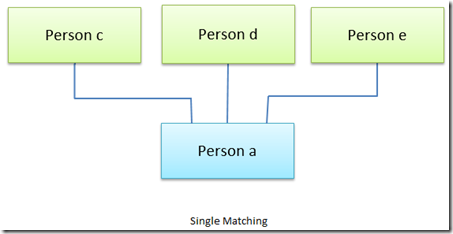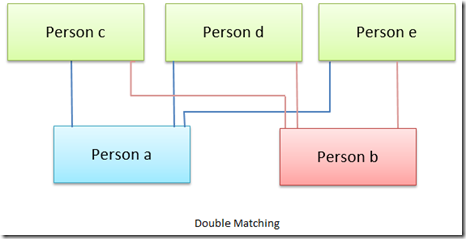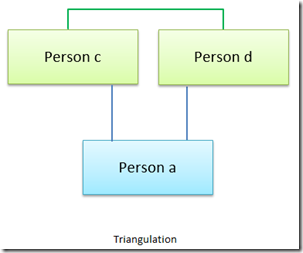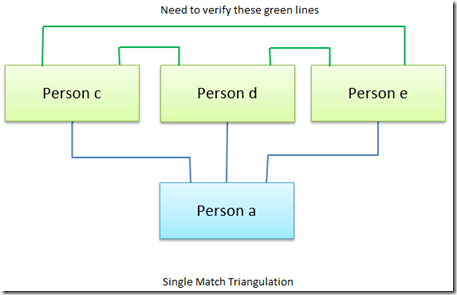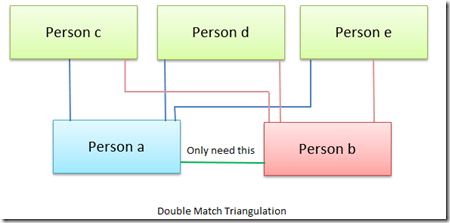Important Note: After this article was written, I found many people had trouble understanding the concepts, as the diagrams were confusing them more than helping them.
This article has been completely rewritten (just two days later) and uses a different diagramming that is akin to looking at the matches in a Chromosome Browser. It should not only be much more easy to understand, but it adds comparisons with the ADSA and GEDMatch Triangulation tools.
I’m leaving this article here as another method of explaining the same thing, but if you haven’t read the other article yet, I’d recommend you read it first:
Triangulation, Single Matching and Double Matching
Let’s see if we can define everything in an understandable way.
Single Matching
For Person a, find all the Persons c, d, e, … who match or overlap on the same DNA segment.
This is what FamilyTreeDNA and 23andMe give you today. MyHeritage is promising a Chromosome Browser but no word yet on whether you’ll be able to download segment matches. AncestryDNA does not provide you with your segment match data.
The goal here is to find the people who get that DNA segment from the same common ancestor, Identical by Descent (IBD), as that will prove a relationship. But this must be checked thoroughly, because one of each pair of chromosomes comes from the mother and one from the father, and the DNA company’s matching process cannot distinguish one from another. So any match, one that even criss-crosses between the mother’s and father’s chromosome will count, as will random matches by chance. With small segments below 15 cM in size, there is a significant likelihood of there being a false match that is not IBD. Even above 15 cM, the segments may still be to the different parent. The main technique to help you identify if the segment is IBD is Triangulation (see below).
Double Matching
For Person a and For Person b, find all the Persons c, d, e,… who match both Person a and Person b on the same segment.
This is what my Double Match Triangulator Program will give you today. And this is what you want FamilyTreeDNA, 23andMe, AncestryDNA and MyHeritage to be giving you.
Double matching does a lot for you. It uses a second person to help confirm that Person c, Person d and Person e all match each other and are not just matches by chance. It eliminates the extra bits of random match that Person a and Person b may have with the third person. If Person a and Person b are not direct-line related (i.e. parent-child, grandparent-grandchild), then it will reduce the threshold of where false matches will occur, down to maybe even 5 cM as Jim Bartlett has concluded. I plan to do a study of this soon and will put my results in an upcoming blog post.
Triangulation
Triangulation is a technique to help conclude (I won’t say “prove”) that three people share a segment that comes from a common ancestor and that the segment is Identical by Descent.
It requires that Person a match Person c on a segment, Person a matches Person d on the same segment and also that Person c matches Person d on the same segment.
This statistically reduces to almost zero the possibility of the criss-crossing matches between the two parental chromosomes. It is still possible that one of the 3 people matches by chance to the other two people. But should that chance match be disproved, maybe by multiple Triangulations with other people, then it can be concluded that these people obtained that common segment from a common ancestor.
Single Match Triangulation
This is the technique commonly in use today because you are only supplied with Single Match information by FamilyTreeDNA and 23andMe.
That matches between Persons c, d and e are not included in the Single Match data you get. You don’t have this information in your matches. What you need to do is contact either Person c, d or e and ask them to look in the Chromosome browser and see for you if they match the other people on that particular segment. If they do, then you Triangulate on that segment. If they don’t match to some of the others, then you’ll have to contact the others to get them to check.
You could have tens of thousands of segments that SIngle Match with others. You may have dozens of people who overlap on a segment. So to be practical, most people just concentrate on their largest size segments, or on a segment connected to people they are trying to figure out their relation to. This is manual labour as far as I’m concerned. And it only verifies one segment for a few people. You have all your others you can do as well that have so much info to give you.
So what people often do is they get lazy. Maybe they verify with one or two people and then incorrectly conclude that all the other matches on the segment are valid. Then maybe they just look to see if the other people are “In Common With” meaning they match somewhere, but not necessarily on the desired segment, and then conclude the segment Triangulates, which is not a conclusion you can make.
Single Match Triangulation is what Jim Bartlett has done over the past five years. He has done it correctly and meticulously. By mapping his segments to his matches, he has manually Match Filtered (I’ll explain what that is in a future blog post) to his parents and has been able to map most of his segments to his ancestors. But it took him 5 years! It’s not easy.
There is one tool that does true Triangulation for you. It is the GEDMatch Tier 1 Triangulation Tool. It is the only online tool that will properly check the third leg of the triangulation for you and guarantee that it is a true Triangulation. All the other tools out there use “In Common With” or less. However, with GEDMatch, you are limited to the kits that have been uploaded there, only your closest 500 matches are used, the minimum cM match is 7 cM and 500 SNPs and it gets cut off at 10,000 Triangulations.
Double Match Triangulation
This is the technique I implemented in my Double Match Triangulator (DMT) program that uses Double Matching.
The basis is simple. Once you’ve Double Matched Person a and Person b with other people on a segment, you have all the matches you need except one: the Person a with Person b match. And that you’ve got that right in your own Single Match file.
The matches between Person a and Person b could then be compared to all the Double Matches, and those that overlap all Triangulate, and those that don’t are Missing a-b Segments (another word I invented).
With the Chromosome Browser Results (CBR) files of Person a and any Person b that is Person a’s match, you can find every segment that Triangulates and all the people that Triangulate with them on every segment in one fell swoop.
If you can get CBR files from more of your DNA matches and put them all together, you will be doing what I call EAST (Extreme Autosomal Segment Triangulation).
Hopefully this post makes the concepts all a bit clearer for you.

